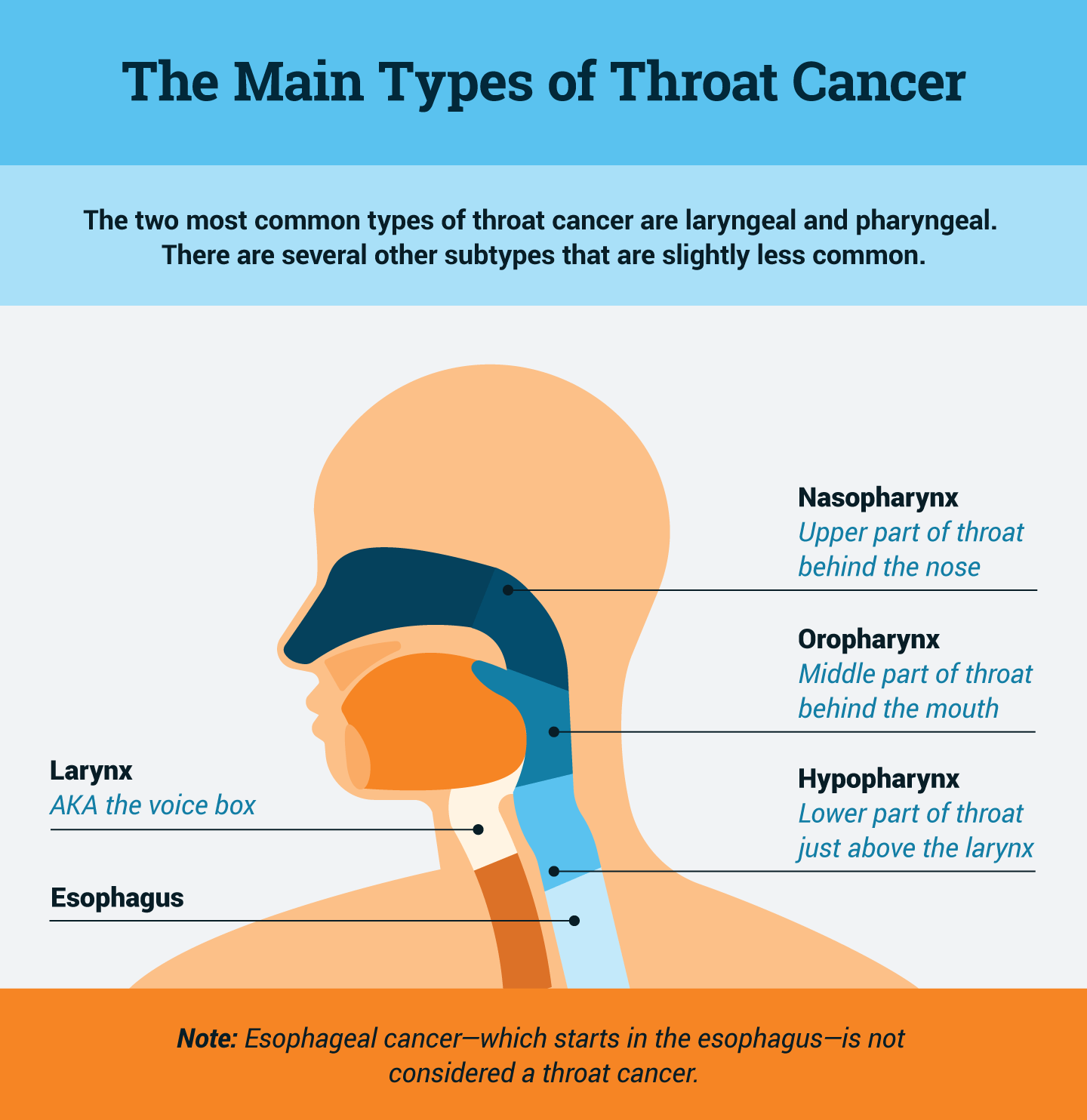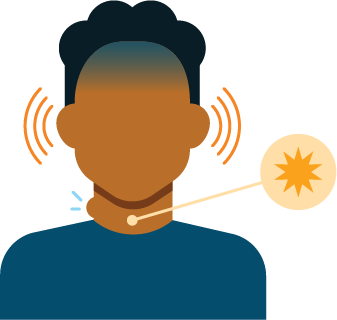2022 Throat Cancer Statistics: Laryngeal, Pharyngeal and More Key Facts
The health of our throat is often taken for granted. When a medical issue arises and impacts the throat, we suddenly realize how critical the organ is for eating, swallowing, breathing and speaking.
Throat cancers affect the lives of thousands of Americans every year. Risk factors include smoking, heavy drinking, human papillomavirus (HPV) and exposure to carcinogens like asbestos.
Making yourself familiar with facts around throat cancers and their risk factors will allow you and your loved ones to stay vigilant in both prevention and monitoring for symptoms. The following list of 40 helpful statistics provide a baseline for better understanding these often-overlooked cancers.
01Understanding the Types of Throat Cancer
Throat cancer is not one thing, as it is made up of several rare forms of cancer affecting different sections of the throat. These cancers are often grouped into a cancer category commonly referred to as head and neck cancers.

The main areas of the throat susceptible to cancer are the larynx, commonly referred to as the voice box, and the pharynx, the long tube connecting your nose and mouth to the esophagus and windpipe.
Cancers impacting the pharynx are named according to which part of the pharynx they originate. These include the nasopharynx, located in the upper part of the throat behind the nose; the oropharynx, located in the middle part of the throat behind the mouth; and the hypopharynx, found in the lower part of the throat just above the larynx.
02How Common Is Throat Cancer?
Throat cancers are fairly rare when compared to all cancer diagnoses.
In 2021, cancer of the larynx represented 0.7% of all new cancer cases and 0.6% of all cancer deaths.
An estimated 12,470 new cases of laryngeal cancer will be diagnosed in 2022.
3,820 people are projected to die from laryngeal cancer in 2022.
The country of Hungary has the highest oropharyngeal cancer rate in the world, more than twice the rate found in the U.S.

Approximately 54,010 adults in America will be diagnosed with oral and oropharyngeal cancer, with men facing rates twice as high as women.
Considered rare, laryngeal cancer is the 22nd most common cancer in America.
An estimated 3,000 people in the U.S. receive the rare diagnosis of hypopharyngeal cancer every year.
Nasopharyngeal cancer is uncommon in the U.S., with fewer than 1 out of 100,000 people diagnosed with it each year.
03Average Age for Throat Cancer and Other Demographics
The average age range for throat cancer diagnoses is between 55 and 64 years old.
Laryngeal cancer patients are typically over age 55, with an average age of 66.
Men die from laryngeal cancer more often than women. The deaths of 3,070 men and 750 women are projected for 2022.

Men are more likely to receive a laryngeal cancer diagnosis, with 9,820 new cases in men projected in 2022 vs. 2,650 in women.
Of the 15,000+ HPV-associated oropharyngeal cancers diagnosed annually, the majority of diagnoses (12,000+) were reported in males.
The lifetime risk of developing laryngeal cancer is about 1 in 190 for men and 1 in 830 for women.

Black men are more likely than white men to develop and die from laryngeal cancer.
04Symptoms, Early Detection and Diagnosis
Like most cancers, recognizing symptoms of throat cancers coupled with early diagnoses improve chances of survival.
Common symptoms of laryngeal cancer include pain when swallowing, hoarse voice and ear pain.
Due to hypopharyngeal cancer often developing without visible symptoms and its challenging location in the body, it is often diagnosed at a more advanced stage than other cancers.
Most laryngeal cancer is identified in Stage 1.
Stage 1 = 52%
Stage 2 = 25%
Stage 3 = 19%
Unstaged = 4%

Currently there are no screening tests to identify laryngeal and hypopharyngeal cancers early.
Potential symptoms of pharyngeal cancer include:
- Trouble breathing/speaking/swallowing
- A lump or thickening
- Lingering throat pain
- Persistent ringing or pain in the ears

60% of laryngeal cancers originate in the glottis (the area containing the vocal cords) and 35% develop in the supraglottis (above the vocal cords).
05Is Asbestos Linked to Throat Cancer?
Asbestos exposure has been identified as a cause of some forms of throat cancer.
Asbestos exposure is a known risk factor for laryngeal and pharyngeal squamous cell carcinoma.
The development of laryngeal cancer from asbestos is dose-dependent and is impacted by the intensity or duration of the asbestos exposure.
Inhaled asbestos fibers may lodge in the voice box on the way to the lungs, leading to laryngeal cancer.

Asbestos fibers that are inhaled or swallowed can collect in the hypopharynx, which can potentially cause hypopharyngeal cancer.
Workers in the construction industry may face extended asbestos exposure on job sites, which can lead to laryngeal cancer.
Smoking and heavy drinking drastically increase risks of laryngeal cancer when combined with asbestos exposure.

06Throat Cancer Survival Rates and Life Expectancy
Long-term survival rates for those with throat cancers increase the earlier the disease is diagnosed.
60.7% of patients survive 5 years or longer after a laryngeal cancer diagnosis.
The 5-year survival rate for hypopharyngeal cancer is 32% but jumps up to 59% if the cancer was diagnosed in Stage 1.

Laryngeal cancers found in the glottis receive a better prognosis than those found in the supraglottis.
Two-thirds of laryngeal cancer patients who did not receive the recommended treatment of a laryngectomy experienced significantly worse survival rates than those who did have the surgery.

50% of oropharyngeal cancer patients are expected to survive 5 years or longer after diagnosis.
The 5-year survival rate for nasopharyngeal cancer is 61%.
07Causes, Risk Factors and Prevention
Changes in behavior are the best ways to limit throat cancer risks.
Approximately 70% of oropharyngeal cancer cases are linked to HPV, the most common sexually transmitted disease in the U.S.
Tobacco use and excessive alcohol use are considered major risk factors for multiple head and neck cancers.
Researchers continue to study how the Epstein-Barr virus is able to develop into nasopharyngeal cancer.
Throat cancer risks can be reduced by:
- Not smoking
- Only drinking alcohol in moderation
- Eating a healthy diet of fruits and vegetables
- Practicing safe sex to limit exposure to HPV
- Preventing asbestos exposure

As smoking rates decline, the rate of new cases of laryngeal cancer is falling by about 2% to 3% a year.
Nasopharyngeal cancer is most commonly diagnosed in Asians and Pacific Islanders in the U.S., particularly among Chinese Americans.
The HPV vaccine may prevent oropharyngeal cancers.
Exposure to wood dust, formaldehyde, asbestos, nickel and other chemicals can increase the risks of developing throat cancer.

08The Importance of Throat Cancer Awareness
While throat cancers are not the most prevalent cancers in the United States, they still pose a danger to many, as the statistics above show. Education on the topic can help people combat risk factors, which include smoking and asbestos exposure. Creating a knowledge base of throat cancers can assist in critical conversations with your medical team.
09Throat Cancer Resources
- A wealth of information and resources on all forms of cancer are available from the American Cancer Society. The organization offers in-depth information about laryngeal, hypopharyngeal, nasopharyngeal and oropharyngeal cancers.
- The Mesothelioma Center works to build awareness about mesothelioma and other asbestos-related cancers, such as laryngeal cancer and pharyngeal cancer.
- Founded in 1944, the nonprofit CancerCare provides free professional support services to help people manage the emotional, practical and financial challenges of many types of cancer, including head and neck cancers.
- The Oral Cancer Foundation is home to a comprehensive and regularly updated list of news and resources for those battling oropharyngeal cancer.
- Support for People with Oral and Head and Neck Cancer (SPOHNC), pronounced "Spunk," is a nonprofit organization that helps develop programs of support to meet the psychosocial needs of patients. It also promotes physical and emotional health for patients.
- The United Kingdom-based Throat Cancer Foundation offers a variety of relevant information in support of patients and families dealing with the disease, including personal stories, nutrition information and expert advice.

